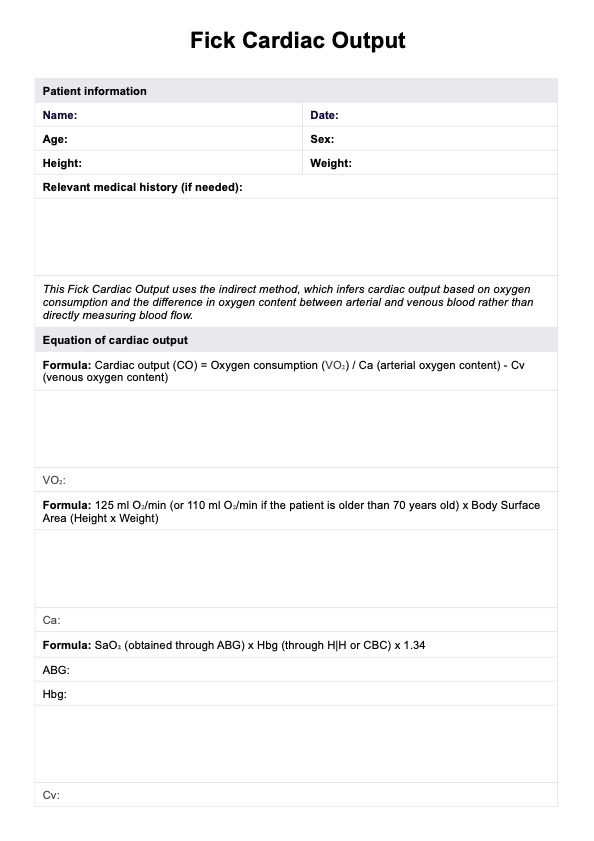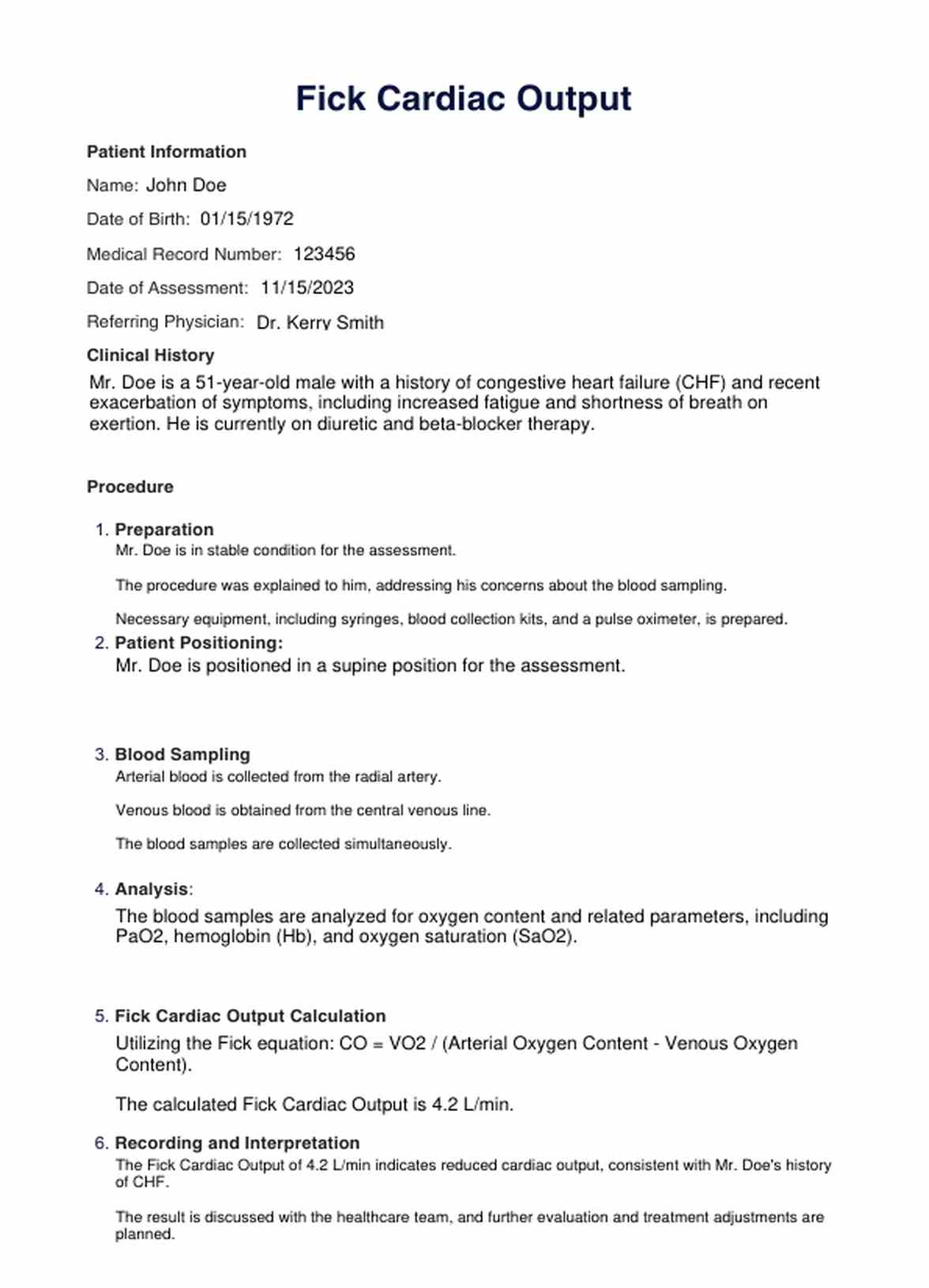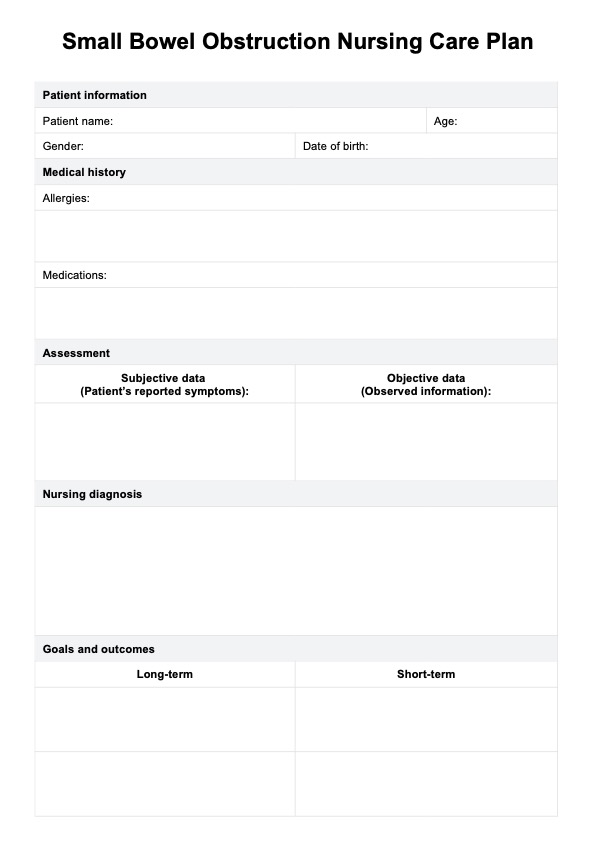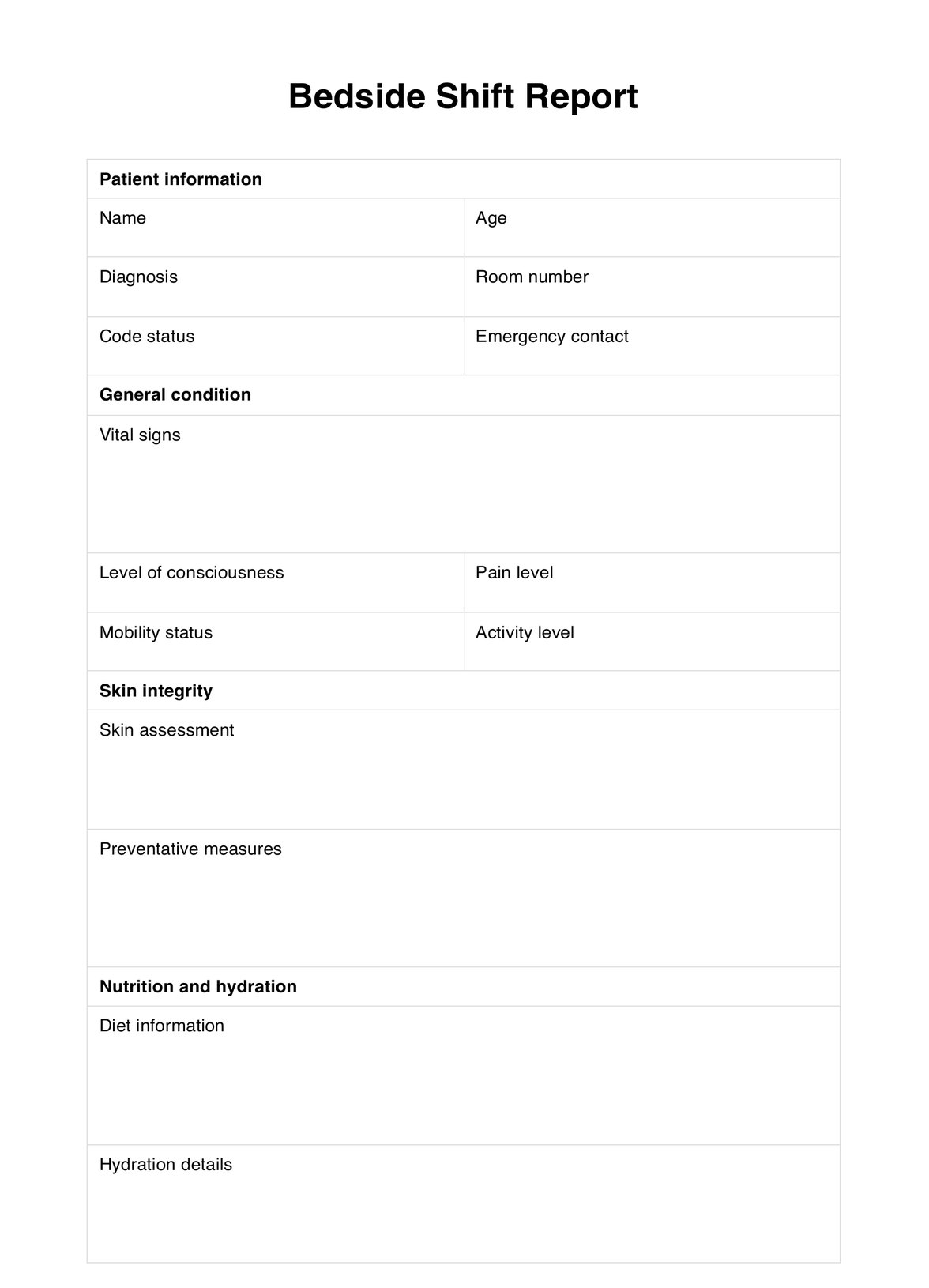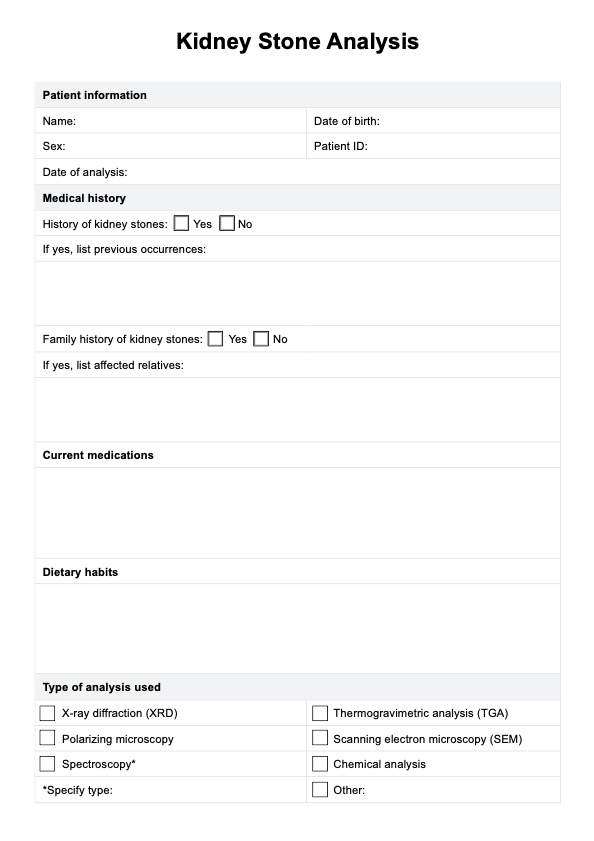Fick Cardiac Output
Enhance cardiac assessments with the Fick Cardiac Output measurement. Download a comprehensive PDF template for structured evaluations. Optimize patient care.


What Is a Fick Cardiac Output?
A Fick Cardiac Output is a crucial medical measurement to assess the heart's efficiency in delivering oxygen to the body's tissues. It is named after its creator, Adolf Eugen Fick, a German physiologist who developed the Fick principle in the late 19th century. This principle forms the foundation for calculating cardiac output, an essential parameter in cardiology and critical care medicine.
The cardiac output represents the volume of blood that the heart pumps per minute, reflecting its overall performance. It is measured in liters per minute (L/min) and is a vital indicator for assessing cardiac health. A Fick Cardiac Output specifically utilizes the Fick principle to determine this measurement.
The Fick principle relies on the principle of conservation of mass. It posits that the rate of oxygen consumption by the body is equal to the rate at which the blood delivers oxygen. By measuring the difference in oxygen content between arterial and venous blood, along with the oxygen consumption of the body, clinicians can calculate cardiac output.
The equation for Fick Cardiac Output is:
Cardiac Output (CO) = Oxygen Consumption (VO2) / (Arterial Oxygen Content - Venous Oxygen Content)
This formula measures how well the heart delivers oxygen to meet metabolic demands. It is a valuable tool in diagnosing and managing heart conditions, monitoring patients during surgery or critical care, and assessing overall cardiac health.
Fick Cardiac Output Template
Fick Cardiac Output Example
How Does It Work?
Gather Patient Information
Begin by collecting essential patient information, including their name, age, sex, and relevant medical history. This information is vital for accurate assessment.
Oxygen Consumption (VO2)
Measure the patient's oxygen consumption, typically using a metabolic cart or indirect calorimetry. This reflects the body's oxygen requirements and is a crucial parameter in the Fick equation.
Obtain an Arterial Blood Sample
Draw an arterial blood sample, often from the radial or femoral artery. This sample will be used to determine the arterial oxygen content.
Obtain Venous Blood Sample
Collect a venous blood sample, typically from the central venous line. The venous oxygen content is essential for the Fick equation.
Oxygen Content Calculation
Calculate the oxygen content for both the arterial and venous blood samples, taking into account the partial pressure of oxygen (PaO2), hemoglobin levels (Hb), and oxygen saturation (SaO2).
Cardiac Output Calculation
Utilize the Fick equation to calculate the cardiac output. The equation is:
CO = VO2 / (Arterial Oxygen Content - Venous Oxygen Content)
Substitute the values obtained in steps 3, 4, and 5 to determine the cardiac output.
Recording and Analysis
Record the calculated cardiac output value in the Fick Cardiac Output form. Analyze the result in the context of the patient's clinical condition and specific cardiac goals.
Interpretation and Action
Interpret the obtained cardiac output value. Depending on the context, this measurement may guide clinical decisions, such as adjusting medication or interventions to optimize cardiac function.
Document Findings
Ensure accurate documentation of the Fick Cardiac Output measurement in the patient's medical record for future reference and continuity of care.
Regular Monitoring
In critical care settings or when managing cardiac conditions, it is essential to perform regular Fick Cardiac Output measurements to track changes and adjust treatment strategies accordingly.
When Would You Use This Output?
The Fick Cardiac Output measurement is a powerful tool for healthcare practitioners, especially in specific clinical situations where it provides critical insights into cardiac function. Here are the key scenarios in which using the Fick Cardiac Output is most appropriate:
- Diagnosis of Heart Conditions: Fick Cardiac Output is essential for cardiologists when diagnosing heart diseases like congestive heart failure, valvular disorders, and congenital heart defects. It helps establish baseline cardiac function for accurate diagnosis.
- Open-Heart Surgery: Cardiac surgeons rely on it during open-heart surgeries, ensuring the heart functions optimally while the patient is on bypass. It guides them in making real-time adjustments during the procedure.
- Complex Surgeries: Anesthesiologists use it to monitor cardiac performance during complex surgeries, particularly in high-risk cases. It assists in tailoring anesthesia and hemodynamic management.
- Critical Care Management: Intensive care specialists employ Fick Cardiac Output in ICUs, especially for critically ill patients with conditions like sepsis and shock. It provides essential data for hemodynamic assessment and guides treatment choices.
- Advanced Lung Diseases: Pulmonologists may utilize it when evaluating patients with progressive lung diseases that impact cardiac function. It aids in developing comprehensive treatment plans.
- Sports Medicine: Sports medicine specialists use it to assess cardiac performance and oxygen delivery in athletes. It's crucial for optimizing training regimens and monitoring cardiovascular health.�?�
- Clinical Research: In clinical research, Fick Cardiac Output is applied to assess the effectiveness of new cardiovascular treatments and interventions. It provides an objective measure for evaluating therapeutic outcomes.
What do the Results Mean?
Interpreting the results of a Fick Cardiac Output measurement is crucial for healthcare practitioners to understand a patient's cardiac performance. The values obtained provide insights into how effectively the heart delivers oxygen to the body. Here, we describe common results and what they mean in the context of this assessment.
- Normal Range: A typical Fick Cardiac Output value for a healthy adult at rest falls from 4.0 to 8.0 liters per minute (L/min). This indicates that the heart is efficiently supplying the body's oxygen demands.
- Low Cardiac Output: If the Fick Cardiac Output measurement falls below the normal range, it suggests reduced cardiac efficiency. Common causes include heart failure, severe heart valve disease, or cardiogenic shock. Low cardiac output can result in symptoms like fatigue, shortness of breath, and reduced exercise tolerance.
- High Cardiac Output: An elevated Fick Cardiac Output may indicate conditions like anemia, hyperthyroidism, or certain congenital heart defects. While high cardiac output can initially be compensatory, it may lead to long-term strain on the heart and an increased risk of heart failure.
- Interpretation in Context: The interpretation of Fick Cardiac Output results should always consider the patient's clinical condition, medical history, and specific assessment goals. It is essential to correlate the findings with other diagnostic tests and clinical symptoms to determine the underlying cause and guide treatment decisions.�?�
- Treatment Implications: Low cardiac output often requires interventions like medication adjustments, fluid management, or even mechanical circulatory support in severe cases. High cardiac output may necessitate addressing the underlying condition, such as treating anemia or managing thyroid disorders.
Research & Evidence
The Fick Cardiac Output measurement finds its roots in the pioneering work of the late 19th-century German physiologist Adolf Eugen Fick and his revolutionary Fick principle (De Maria & Raisinghani, 2000). This principle, which forms the foundation for calculating cardiac output, is firmly grounded in the conservation of mass, asserting that the oxygen consumption rate is equal to the rate at which the blood delivers oxygen. This groundbreaking concept significantly advanced our understanding of cardiac physiology, becoming a cornerstone in cardiology and critical care medicine.
Over the years, the Fick principle and its application in measuring cardiac output have undergone extensive research, resulting in a substantial body of evidence that highlights its reliability and clinical value. Key developments in this journey include Fick's initial studies that laid the groundwork for the Fick principle (Guyton, Charles, & Berry, 1959) and the ongoing refinement of techniques to enhance measurement accuracy (Godfrey, 1970).
Clinical validation studies across various patient populations and settings have further solidified the Fick Cardiac Output's credibility as a diagnostic and monitoring tool (Kresoja et al., 2019). Additionally, rigorous comparison studies have consistently demonstrated the reliability and accuracy of Fick Cardiac Output, especially when compared to alternative measurement methods such as thermodilution (Themes, 2017).
This research progress and the Fick principle's inclusion in clinical practice guidelines underscore its significance as a trusted method for evaluating cardiac function (Nickson, 2020). Continuous exploration and innovation in the field ensure that the Fick Cardiac Output measurement remains at the forefront of cardiac assessment (Melamed et al., 2019). In this way, it plays an indispensable role in diagnosing and managing a diverse range of cardiac conditions, reaffirming its relevance in modern healthcare practice.
References
De Maria, A. N., & Raisinghani, A. (2000). Comparative overview of cardiac output measurement methods: Has impedance cardiography come of age? Congestive Heart Failure, 6(2), 60??73. https://doi.org/10.1111/j.1527-5299.2000.80139.x
Godfrey, S. (1970). Manipulation of the indirect fick principle by a digital computer program for calculating exercise physiology results. Respiration, 27(6), 513??532. https://doi.org/10.1159/000192707
Guyton, A. C., Charles, A. F., & Berry, A. J. (1959). A continuous cardiac output recorder employing the Fick principle. Circulation Research, 7(4), 661??665. https://doi.org/10.1161/01.res.7.4.661
Kresoja, K., Faragli, A., Abawi, D., Paul, O., Pieske, B., Post, H., & Alogna, A. (2019). Thermodilution vs estimated Fick cardiac output measurement in an elderly cohort of patients: A single-center experience. PLOS ONE, 14(12), e0226561. https://doi.org/10.1371/journal.pone.0226561
Melamed, R., Mikel, B., Kirkland, L. L., Tierney, D. M., Huguelet, J., St Hill, C., Agboto, V., & Samara, M. A. (2019). 196. Critical Care Medicine, 47, 80. https://doi.org/10.1097/01.ccm.0000550951.15352.f6
Nickson, C. (2020, November 3). Cardiac output measurement. Life in the Fast Lane ? LITFL. https://litfl.com/cardiac-output-measurement/
Themes, U. (2017, April 25). 6: Cardiac output. Thoracic Key. https://thoracickey.com/6-cardiac-output/
Commonly asked questions
Cardiologists, cardiac surgeons, anesthesiologists, and intensive care specialists commonly request Fick Cardiac Output measurements. They are essential for assessing cardiac performance in patients with various heart and critical care conditions.
Fick Cardiac Outputs are used in clinical scenarios like diagnosing heart diseases, monitoring patients during surgeries, assessing critically ill patients in ICUs, and evaluating athletes' cardiovascular health in sports medicine. These measurements provide crucial insights into cardiac function.
To measure Fick's Cardiac Output, arterial and venous blood samples are obtained. The oxygen content of these samples is calculated, and the cardiac output is determined using the Fick equation. This calculation assesses how efficiently the heart delivers oxygen to the body.
How long does a Fick Cardiac Output take?
A Fick Cardiac Output measurement typically takes about 30 minutes to an hour, including the time required for blood sample collection and analysis. The duration may vary based on the patient's condition and the clinical setting.


